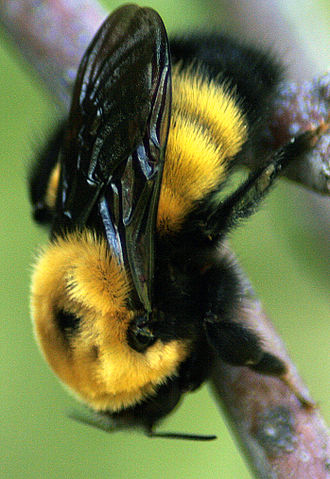Anatomy
Roots
Vaccinium corymbosum have two different
types of roots. The first type of root is a thick root that is
meant to serve as an anchor for the plant and also acts as a storage
site for nutrients, especially during the winter. The second type
of roots are the finer roots. They function in nutrient and water
absorption. Interestingly, highbush blueberry roots lack root
hairs.
Shoot
The most obvious function of the shoot is to support
the plant. The shoot hold the highbush blueberry upright, allowing
it to grow taller than grasses and other plants it is competing with.
The shoot also serves as a 'highway' for transport for nutrients and
water between the roots and the leaves. Inside the shoot is xylem
and phloem for this purpose. Both primary growth (upwards) and
secondary growth (increase in girth) occurs in Vaccinium corymbosum.
Leaves
The leaves of the highbush blueberry play a critical
role in the plants survival; they are the site of photosynthesis.
They also help the plant to detect how long the days are (based on
the amount of sunlight it is receiving), which determines when the
vegetative buds will become flowering buds. The leaves of
Vaccinium corymbosum can grow to be up to 75 millimeters long.
Flowers
The flowers are the reproductive organ of the
Vaccinium corymbosum. The flower is usually white or
off-white and has five fused petals. The major structures of the
flower include the corolla tube, the pistil, and the anthers:

Corolla tube - The corolla tube consists of all of the petals put together. It serves to protect the internal organs of the flower from rain and moisture.
Pistil - The pistil is the female reproductive part of the flower. It contains the stigma, style, and ovary.
Anther - The anther is essentially a sack of pollen attached to the end of the stamen, which is attached at the base of the corolla tube.
Reproduction and Life Cycle
Vaccinium corymbosum, like all other plants, undergoes what is known as alteration of generations. Alteration of generations means that the organism has both a multi-cellular diploid and a multi-cellular haploid stage in its life cycle. In plants, alteration of generations can be illustrated simplistically by the following diagram:
As mentioned above, the flower is the reproductive organ of the highbush blueberry. But just how does the fertilization and reproduction occur in the flower?
Vaccinium corymbosum has help from from other organisms - specifically bees. When bees land on a flower, pollen grains from the anther get stuck to various parts of the bee's body. The bee then flies to another flower of the same species and transfers the pollen to the stigma of another flower, where the fertilization occurs. The bee does this all without knowing it! The process of fertilization in a flower is known as pollination. After pollination takes place, pollen tubes are formed that grow down the style and into the ovary.

The next step is fruit formation. In the Vaccinium corymbosum, the ovary develops into the actual berry after pollination. The berry, which is the fruit, protects embryos (the seeds) from the outside world. It also serves as a seed dispersal mechanism. Many animals eat the blueberry but are unable to digest the seeds. After the animal has traveled around for a while, the seeds leave the animal's body in feces during defecation. The seeds are then ready to grow into a new plant.
The following diagram sums up the life cycle of the highbush blueberry:
As you can see, the life cycle of the highbush
blueberry is quite interesting. Advance to the
Interactions page to find out about other
organisms involved in the life a Vaccinium corymbosum cultivar.
Return to homepage


